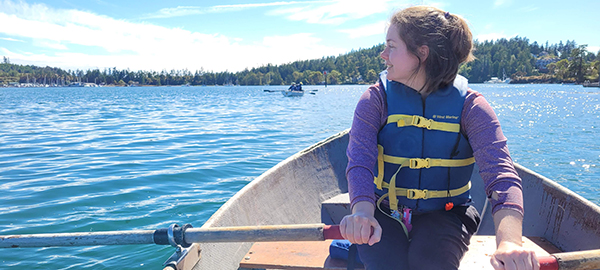Dr. Holly Shelton holds a PhD from the University of Washington in language and rhetoric along with MA degrees in Applied Linguistics and Teaching English to Speakers of Other Languages. She has taught in Chile, Turkey, Canada, Kazakhstan, and the US; received several awards for teaching over her career; and most recently been awarded a publication prize for her book chapter “Framing Crisis in Seattle During COVID-19 and BLM: Faith in Generative Dialogue,” which she wrote while stationed at FHL.

In Spring 2020, I was debating the wisdom of returning to UW Friday Harbor Labs to teach the Science Writing class. It was early in the pandemic, my in-person classes at the Seattle campus had all been shifted online the last week of Winter quarter, and the CDC had identified my parents as part of a vulnerable category. I discussed the situation with Megan Dethier, and she described the Labs as a ghost town. After some soul searching I let her know I'd decided to help haunt the place after all, as originally planned.
To understand the unique challenges and opportunities of this time period, it is helpful to explore the way we think of time itself. Rhetoric is heavily influenced by its Greek roots, and Greek language distinguishes between different kinds of time: chronos and kairos. Chronological time (from chronos) is how most people think of time in English, but kairos is more of a moment in time, or a window of opportunity, when certain actions become more possible. Kairos involves some extra poise and adaptability in responding to unique moments — like researchers studying birdsong, who were able to document changes in suddenly-silent cities under pandemic lockdowns (Derryberry et al, 2020). I adjusted my course reading list. What appeared as a peer-reviewed article in Science titled “Singing in a silent spring: Birds respond to a half-century soundscape reversion during the COVID-19,” became “How lockdown birds sang to a different tune” in
BBC and “Bird songs got sexier during the COVID-19 shutdown” in
Popular Science. This was research and writing circulation in action.
Like many instructors I was concerned with the loss of
what had been, like the hands-on field experience at FHL that situates and enriches student writing. However, I began leaning into
what could be, like digital citizen science projects on the Zooniverse platform to ground student writing as they gained expertise in specific topics. Students elected to work on projects like testing the photo identification potential of beluga whales, locating kelp forests from satellite imagery, counting and identifying sea birds and their young from wildlife cameras, or identifying invertebrate species from photos of tiles that had been hung from structures like docks (special thanks to the Smithsonian Institute for adding extra data to their “Invader ID” project upon request specifically for our class). The research teams posting Zooniverse projects often had academic publications in addition to the materials describing their projects to recruit volunteers, which provided models for analysis of science writing for different audiences and purposes. The specific projects students chose from Zooniverse also served as springboards to follow lines of inquiry into topics of their own interest, like the role of sea birds as indicators of environmental change or marine mammal travel patterns.
While new forms of distance and isolation seemed prevalent, many “visiting experts” for whom distance could normally be prohibitive also became more available during this time via video call on Zoom. A team of librarians met with the FHL students to show them how to access relevant research through UW databases, and a guest speaker from a local project, the “Young-of-Year Rockfishes Citizen Science Survey,” was able to talk with the class about the research team’s process on preparing written materials for different audiences and purposes. Each of the classes during the pandemic experienced a unique range of experts talking about their research activities and connections to their writing within an overall activity system.
Over the four quarters teaching at FHL, I adapted to three different configurations of the writing class: once as a traditional in-person setting, once as an online course and twice as a modified pod-based course in which students lived with up to five pod-mates and kept masked distance from others outside their pod during classes and other activities during COVID. The online configuration encouraged us to practice grace for each other and ourselves while responding to unexpected challenges of technology and wellness. We used collaboratively edited Google Slides with materials for writing activities along with Zoom video-call meetings to coordinate synchronous class sessions. The pod-based configuration inspired gratitude for our learning community and unique opportunities for place-based learning and access to nature. I began including a photo of the day from the area around FHL on our Google Slides to coordinate with students' weekly observation journals and "sense of place" cultivated in other classes. For some students, their pod-based quarter at FHL in the 2020-2021 academic year was their first in-person university experience, so the social connections at FHL were even more poignant. I was able to help coordinate activities like artistic algal pressing workshops, poetry and storytelling bonfires, paint nights, and line dancing (which not only requires no touching, but easily incorporates social distancing requirements).